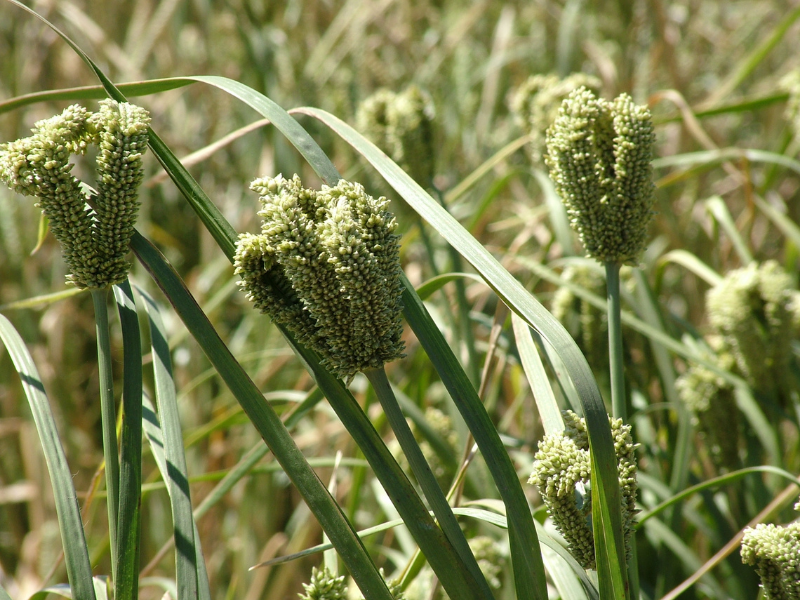USA
May 9, 2022
The grain called finger millet may not be well-known outside of Africa, but it is an important crop to the region. Finger millet has been farmed in eastern Africa for thousands of years. However, breeding the crop for better traits has been difficult for local farmers.

This image shows healthy finger millet plants in a field trial in Ethiopia. Finger millet is a well-known and important crop grown in Africa. Credit: Katrien Devos
Katrien Devos, a professor at the University of Georgia, and her colleagues are collaborating with scientists from Kenya to improve the grain’s yield and quality. “Breeding has traditionally been done, and is still often done, by selecting improved lines within existing cultivars,” she explained. “Breeders essentially rely on occasional spontaneous outcrossing events in which pollination occurs with pollen from a nearby growing variety rather than self-pollen to generate new combinations. We have been working with breeders in eastern Africa to bring finger millet breeding into the 21st century."
This study was published in the Plant Genome Journal, a publication of the Crop Science Society of America.
The team set out to find a way to provide breeders with better tools to improve millet traits in a targeted way. This meant digging into the DNA of finger millet to find genes that are responsible for beneficial traits. This is no easy task, says Devos.
The researchers used a technique called genotyping-by-sequencing. This is a form of sequencing where a small portion of the genome is sequenced that represents the broader whole. This saves time and money and allows the researchers to have enough data for genetic mapping. This mapping allowed them to find potential genes or areas on the genome responsible for certain traits, called quantitative trait loci.

Blast fungal infections on finger millet can impact different parts of the plant. There can be infections in the panicle (head blast), the peduncle (neck blast), and leaves (leaf blast). Blast disease is the main disease that impacts finger millet in eastern Africa. Credit: Katrien Devos
“Most traits are controlled by multiple genes,” Devos says. “In order to find the genes that control a trait of interest, this analysis is carried out. The chromosome regions that contribute to the expression of the trait are identified using computer models.” She adds that these areas on the genome can then be identified using DNA markers so that breeders can more easily use them to improve the crop. Once breeders understand how traits are manifested, she says, they can plan their breeding efforts more easily.
They assessed traits that greatly affect the yield of the crop such as panicle number, disease resistance, and maturity time. Panicles are where the grains form. In areas with drought, an early maturity time is best.
The main disease that impacts finger millet in eastern Africa is blast disease, which is caused by a fungus. The fungus can infect the leaves of the plant but is worst when it impacts the panicle. “Infection during flowering or grain development is most destructive,” Devos says. “It can lead to yield losses of up to 90% under environmental conditions that are favorable for disease development. A lot of research has been done on rice blast, but work on finger millet blast is still in its infancy.”

Researcher Katrien Devos bags emerging finger millet panicles in the greenhouse at the University of Georgia to ensure self-pollination. Credit: Emma Bennetzen
She adds that fungicides can be used to control the disease but can be very costly. Breeding for resistance is the only approach that would allow for sustainable finger millet production.
Their research also compared finger millet to other similar crops. Because not much is known about the finger millet genome, comparing it with crops like rice and sorghum may help them make educated guesses about what some of its genes may be responsible for.
Devos describes finger millet as an “orphan crop” because it has largely been ignored by the international research community. Devos was one of the pioneers that developed the idea of comparing finger millet genetics to other grains. “My lab, together with collaborators in the United States and eastern Africa, have been working over the past six or so years to fill this void,” Devos explains. “Still, finger millet research is lagging compared to other cereal grains, but we can draw on and apply knowledge that is available in the major cereals to finger millet. This transfer of knowledge allows us to make faster progress in orphan crop species.”
Funding for this research was provided by the National Science Foundation and the Bill and Melinda Gates Foundation.